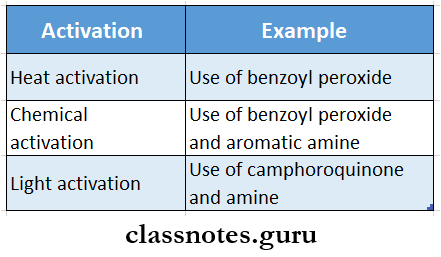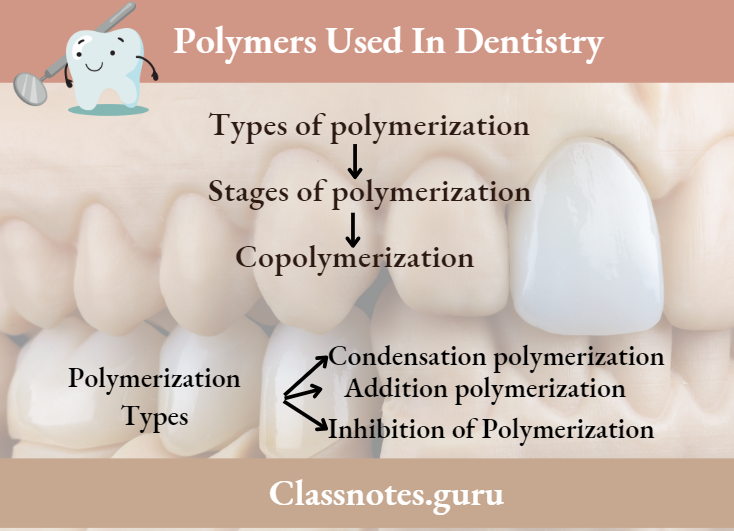Dental Polymers Important Notes
1. Types Of Polymerization
- Condensation polymerization
- Involves combining two dissimilar molecules into a third entirely different product
- Ex: phenol and formaldehyde to form Bakelite
- Addition polymerization
- When similar molecules are combined the reaction is called an addition reaction
- In it, the monomer is repeated many times to form a polymer
- No by-products are formed
- Example: polymethylmethacrylate
2. Stages Of Polymerization
- Initiation
- Propagation
- Termination
- Chain transfer
3. Copolymerization
- Resin formed by two or more chemically different monomers is called copolymer
- The process of formation is called copolymerization
Read And Learn More: Dental Materials Question and Answers
Dental Polymers Long Essays
Question 1. Describe polymerization mechanisms. Add a note on stages in addition to polymerization.
Answer:
Polymerization:
- It is the chemical reaction in which monomers of low molecular weight are converted into chains of polymers with a high molecular weight
- Monomer + Monomer + Monomer+ → Polymer
- These monomers are connected by bonds
- It is a repetitive intermolecular reaction
Polymerization Types:
1. Condensation polymerization
- It is divided into two groups
- Those in which polymerization occurs along with the repeated elimination of small molecules
- Those in which functional groups like amide, and ester are repeated
2. Addition polymerization
- In this type of polymerization, monomers are repeated and every time one molecule is added the chain continues
- There is no change in chemical composition and no by-products are formed
Inhibition of Polymerization: Polymerization is inhibited by
Polymer And Monomer In Dentistry
1. Impurities
- Any impurity in the monomer that can react with free radicals inhibits or retards the polymerization
- It occurs during storage
- Example: The addition of a small amount of hydro-quinone inhibits polymerization
2. Oxygen It reacts rapidly with free radicals and retards polymerization
Polymers Used In Dentistry
Stages of Addition Polymerization: There are four stages of addition polymerization
1. Induction
- It is the time during which the molecules of the initiator become activated
- It is the activation of free radicals which in turn initiate growing polymer chains
- Thus, this stage is controlled by activation and initiation
- Any impurities present increase the length of the induction period
- It is useful for dental resins
- These resins are activated by heat, chemicals, and light

- Example: Amine acts as an activator and benzoyl peroxide as an initiator for dental resins
2. Propagation
- It is a stage of polymerization during which polymer chains continue to grow to high molecular weights
- It is accompanied by the liberation of heat. Thus it is an exothermic reaction
- The growth of the polymer chain stops if the reactive center is destroyed by the termination reaction
3. Chain Transfer
- During this stage, the growing end of a chain is transferred to another molecule and initiates further chain growth
- Here the active state is transferred from active radical to inactive molecule
Polymerization In Dentistry
4. Termination It occurs through two processes
- Direct coupling of two free radical end chains
- The two molecules combine and become deactivated by the formation of a covalent bond
- Exchange of hydrogen atom
- The hydrogen atom is transferred from one growing chain to another
- A double bond is produced between them

Dental Polymers Short Question And Answers
Question 1. Copolymerization
Answer:
Copolymerization
- It is the process of polymerization where two or more chemically different monomers combine to form polymers called copolymers.
- There are three different types of copolymers
Polymer And Monomer In Dentistry
- Random type
- Graft type
- Block type
Importance of Copolymerisation: It is used to improve the physical properties of resins

